1. Basics of Geometry
- Books Name
- CBSE Class 6 Mathematics Book
- Publication
- Param Publication
- Course
- CBSE Class 6
- Subject
- Mathmatics
Introduction
The term ‘Geometry’ is the English equivalent of the Greek word ‘Geometron’. ‘Geo’ means Earth and ‘metron’ means Measurement. Here, we will discuss some basic concepts in geometry.
1. Basics of Geometry
- Books Name
- Class 6 Mathematics Book
- Publication
- ReginaTagebücher
- Course
- CBSE Class 6
- Subject
- Mathmatics
Chapter - 4
Basic Geometrical Ideas
Introduction to geometry
Geometry has a long and rich history. The term 'Geometry' is derived from the Greek word 'Geometron'. Geometry is the branch of mathematics which deals with the measurement, properties and relationships of points, lines, angles, surfaces and solids. So here we are going to learn about,
1. Points
2. Line segment
3. Line
4. Ray
5. Plane
6. Intersecting Lines
7. Parallel Lines
8. Curves
9. Polygon,
10. Angle
11. Triangle
12. Quadrilaterals,
13. Circle and its parts
Point and line segment
In geometry, dots are used to represent points. A point is used to represent any specific location or position. It neither has any size, nor dimensions such as length or breadth. A point can be denoted by a capital letter of the English alphabet. Points can be joined in different ways.

Line segment :
A line segment is defined as the shortest distance between two points. A line segment has two end points and a hence a definite length. For example, if any two points, M and N are marked on a sheet of paper, then the shortest way to join M to N is a line segment. It is denoted by ––––MNMN_ and ––––NMNM_. Points M and N are the end points of the line segment.
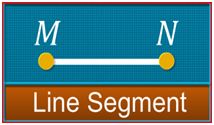
Line and ray
Line :
A line is made up of an infinite number of points that extend indefinitely in either direction. Two points determine a line. For example, if a line segment from M to N is extended beyond M in one direction and beyond N in the other, then we get a line, MN. It is denoted by←−→ MN MN↔. A line can also be represented by small letters of the English alphabet.

Ray:
A ray is a portion of a line. It starts at one point and goes on endlessly in one direction. For example, if a line from A to B is extended endlessly in the direction of B, then we get a ray, AB. It is denoted by −−→ABAB→and can be read as ray AB.

Plane:
A plane is said to be a very thin flat surface that does not have any thickness, and is limitless. A plane is always represented by a minimum of three points.
For example, the sheet shown below is said to be plane ABC. An infinite number of points can be contained within a plane.

Intersecting lines and parallel lines
Intersecting lines:
If two lines pass through a point, then we say that the two lines intersect at that point. Thus, if two lines have one point in common, then they are called intersecting lines. Intersecting lines always intersect, cut or cross each other. For example, If two lines pass though a point P, then the two lines are called intersecting lines.

Parallel lines or non- intersecting lines:
In a plane, if two lines have no point in common, then they are said to be parallel or non- intersecting lines. Parallel lines never meet, cut or cross each other. Parallel lines never meet, cut or cross each other. If two lines m1 and m2 are parallel, we write m1 || m2.

Curve and it types
Curves:
Curves can be defined as figures that flow smoothly without a break. A line is also a curve, and is called a straight curve.

Simple curves:
Curves that do not intersect themselves are called simple curves.

Open curves
Curves whose end points do not meet are called open curves.
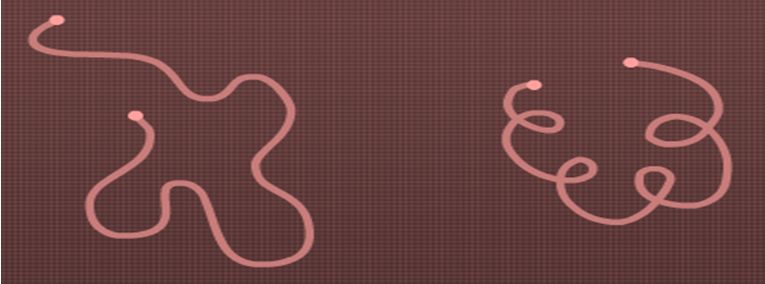
Closed curves:
Curves whose end points join to enclose an area are called closed curves.

For a closed curve, we can identify three regions

The interior of the curve: Green points are in the interior of the closed curve.
Boundary of the curve: Blue points are on the boundary of the closed curve.
Exterior of the curve: Red points are in the exterior of the closed curve.
The interior of a curve together with its boundary is called its “region”.
Polygon
Collinear Points
Three or more points are said to be collinear, if there is a line which contains them all.

In the above figure; P, Q, R are collinear points.
5. INTERSECTING LINES
Two lines having a common point are called intersecting lines. The point common to two given lines is called their point of intersection. In the figure, the lines AB and CD intersect at a point O.
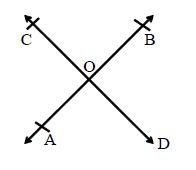
6. PARALLEL LINES
Two lines l and m in a plane are said to be parallel, if they have no point in common and is written as l || m. The distance between two parallel lines always remains the same.

POLYGONS
Simple closed curves made up of only line segments are called polygons. Line segments that form the polygon are the sides of the polygon. Any two sides with a common end point are called the adjacent sides. The point of intersection of a pair of sides is called a vertex. The end points of the same side are adjacent vertices. The line segment joining any two non-adjacent vertices of a polygon is a diagonal. ABCDEF is a polygon.
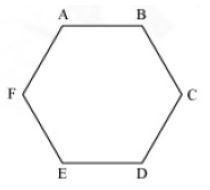
The line segments AB, BC, CD, DE, DF, and FA are known as the sides of the polygon ABCDEF.
Any two sides with common end points are called adjacent sides. AB and BC are adjacent sides with common end point B.
The meeting point of a pair of sides of a polygon is known as vertex. In the polygon ABCDEF, sides AB and BC meets at point B. So, point B is called the vertex of the polygon. Similarly, the other vertices are A, C, D, E, and F.
The line joining any two non-adjacent vertices of a polygon is known as its diagonal. In the following polygon ABCDEF, the diagonals are AC, AD, AE, BD, BE, BF, CE, CF, and DF.
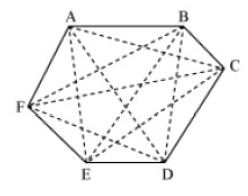
ANGLES
An angle is made up of two rays starting from a common end point.
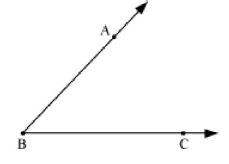
In this figure BA−→−BA→ and BC−→BC→ rays have one common end point, that is, B. The rays BA−→−BA→ and BC−→BC→ are called the arms or sides of the angle. The common end point B is the vertex of the angle.
We name the above angle as ∠∠BAC.
Triangle
TRIANGLES
A polygon made up of three line segments is called a triangle.
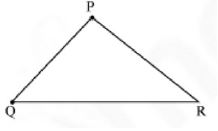
The triangle in the diagram is Δ∆PQR. Points P, Q and R are the vertices. PQPQ , QRQR and RPRP are the sides, and ∠∠PQR, ∠∠QRP, ∠∠RPQ are the angles of the triangle. A triangle has an interior and exterior.
Quadrilaterals
QUADRILATERALS
A quadrilateral is a four-sided polygon.
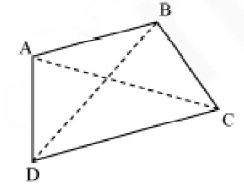
AC and BC are the diagonals of quadrilateral ABCD, ∠∠A and ∠∠C, and ∠∠B and ∠∠D are the opposite angles. ∠∠B and ∠∠C are the adjacent angles. Similarly, the other adjacent angles are ∠∠A and ∠∠B, ∠∠C and ∠∠D, ∠∠D and ∠∠A.
Circle and its parts
CIRCLES
A circle is formed by a point moving at the same distance from a fixed point. The fixed point is the centre of the circle. A circle is also a simple closed curve however; it does not have any sides or angles.
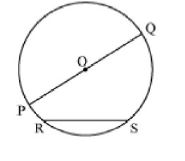
The fixed point O is the centre of the circle.
The fixed distance OP = OQ is the radius of the circle.
The distance around the circle is its circumference.
Circumference
The line that forms the boundary of a circle is called its circumference. The part enclosed by the circumference of a circle is called the interior of the circle. The part left outside the circle is said to be the exterior of the circle. Some points may lie on the circumference of the circle.
Radius
A line segment that joins the centre of the circle and a point on the circumference is called the radius of the circle. The radius of a circle is half of the diameter.
Chord
A chord is a line segment joining two points that lie on a circle.
Diameter
A chord passing through the centre of the circle is called its diameter. A diameter is the longest chord of a circle.
Arc
An arc is a part of the circumference of a circle.
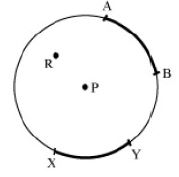
Sector
The part of a circle enclosed by two radii and an arc is called a sector.
Segment
The part of a circle that is enclosed by a chord and an arc is called a segment of the circle.
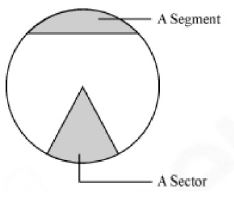
Semi-circle
A diameter of a circle divides it into two halves. Each half is called a semi-circle.
Circles
- Books Name
- CBSE Class 6 Mathematics Book
- Publication
- Param Publication
- Course
- CBSE Class 6
- Subject
- Mathmatics
Circle
A circle is a simple closed curve all of whose points are at the same distance from a given point O in the same plane . The given point O is called the centre of the circle.
It has some very special properties.
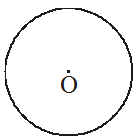
Parts of a circle
Here is a circle with centre C (Fig ) A, P, B, M are points on the circle. We will see that
CA = CP = CB = CM.
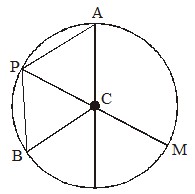
Each of the segments CA , CP , CB, CM is radius of the circle. The radius is a line segment that connects the centre to a point on the circle. CP and CM are radii (plural of ‘radius’) such that C, P, M are in a line. PM is known as diameter of the circle. Diameter is a double the size of a radius.
PB is a chord connecting two points on a circle.
An arc is a portion of circle.
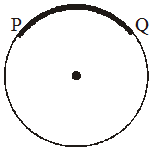
If P and Q are two points we get the arc PQ. We write as . ![]()
As in the case of any simple closed curve we can think of the interior and exterior of a circle. A region in the interior of a circle enclosed by an arc on one side and a pair of radii on the other two sides is called a sector.
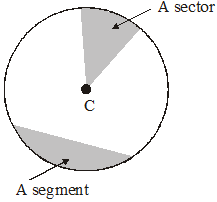
A region in the interior of a circle enclosed by a chord and an arc is called a segment of the circle. The distance around a circle is called its circumference.
Quadrilaterals
- Books Name
- CBSE Class 6 Mathematics Book
- Publication
- Param Publication
- Course
- CBSE Class 6
- Subject
- Mathmatics
QUADRILATERALS
A four sided polygon is a quadrilateral. It has 4 sides and 4 angles.
We named the vertices in a cyclic manner.
This quadrilateral ABCD figure has four sides AB, BC , CD and DA. It has four angles ∠A , ∠B, ∠C and ∠D .
Quadrilateral ABCD, AB and BC are adjacent sides.
AB and DC are opposite sides. ∠A and ∠C are said to be opposite angles;
similarly, ∠D and ∠B are opposite angles.
Naturally ∠A and ∠B are adjacent angles.
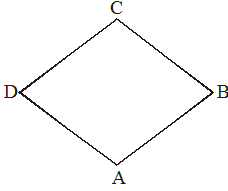
Triangles
- Books Name
- CBSE Class 6 Mathematics Book
- Publication
- Param Publication
- Course
- CBSE Class 6
- Subject
- Mathmatics
TRIANGLES
A triangle is a three-sided polygon. In fact, it is the polygon with the least number of sides.
We write ∆DABC instead of writing Triangle ABC. The three sides of the triangle are AB , BC and CA . The three angles are ∠BAC, ∠BCA and ∠ABC. The points A, B and C are called the vertices of the triangle.
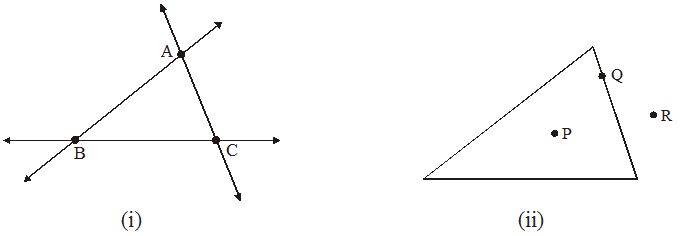
Being a polygon, a triangle has an exterior and an interior. In the figure (ii), P is in the interior of the triangle, R is in the exterior and Q on the triangle.
Angles
- Books Name
- CBSE Class 6 Mathematics Book
- Publication
- Param Publication
- Course
- CBSE Class 6
- Subject
- Mathmatics
ANGLES
An angle is made up of two rays starting from a common end point. The two rays forming the angle are called the arms or sides of the angle. The common end point is the vertex of the angle.
This is an angle formed by rays ![]() and
and ![]() . Angle POQ is thus a better way of naming the angle. We denote this by ∠POQ.
. Angle POQ is thus a better way of naming the angle. We denote this by ∠POQ.
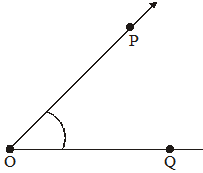
In specifying the angle, the vertex is always written as the middle letter.
Polygons
- Books Name
- CBSE Class 6 Mathematics Book
- Publication
- Param Publication
- Course
- CBSE Class 6
- Subject
- Mathmatics
Polygons
A figure is a polygon if it is a simple closed figure made up entirely of line segments.
For example, triangle, quadrilateral, pentagon, etc., are all examples of polygon.

If all sides of a polygon are equal and all angles are also equal , then it is called a regular polygon.
Sides, Vertices and Diagonals
The line segments forming a polygon are called its sides.
 The meeting point of a pair of sides is called its vertex.
The meeting point of a pair of sides is called its vertex.
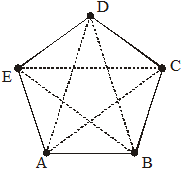
Sides ![]() and
and ![]() meet at E, so E is a vertex of the polygon ABCDE. Points B and C are its other vertices.
meet at E, so E is a vertex of the polygon ABCDE. Points B and C are its other vertices.
Any two sides with a common end point are called the adjacent sides of the polygon. Sides
![]()
The end points of the same side of a polygon are called the adjacent vertices. Vertices E and D are adjacent, whereas vertices A and D are not adjacent vertices.
The line joining two non-adjacent vertices of a polygon is called a diagonal. Since A and C are non-adjacent vertices, so ![]() is a diagonal.
is a diagonal.
Curves
- Books Name
- CBSE Class 6 Mathematics Book
- Publication
- Param Publication
- Course
- CBSE Class 6
- Subject
- Mathmatics
Curves
When we draw lines on a piece of paper without lifting the pencil and without using a scale, the shapes that we get are called curves.
Simple Curve : A curve that does not cross itself is called a simple curve. The figures shown below are simple curves.

Open Curves : The figures that do not begin and end at the same point are called open curves.

Closed Curves : The figures that begin and end at the same point are called closed curves.
For example : triangle, circle, rectangle, square, etc. are all closed figures.

Position in a figure
In a closed curve, thus, there are three parts.
(i) interior (‘inside’) of the curve
(ii) boundary (‘on’) of the curve and
(iii) exterior (‘outside’) of the curve.
In the figure, A is in the interior, C is in the exterior and B is on the curve.
The interior of a curve together with its boundary is called its “region”.
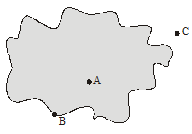
Ray
- Books Name
- CBSE Class 6 Mathematics Book
- Publication
- Param Publication
- Course
- CBSE Class 6
- Subject
- Mathmatics
RAY
A ray is a portion of a line. It starts at one point (called starting point) and goes endlessly in a direction.
Look at the diagram of ray shown here. Two points are shown on the ray. A is the starting point, P is a point on the path of the ray.
![]()

Parallel Lines
- Books Name
- CBSE Class 6 Mathematics Book
- Publication
- Param Publication
- Course
- CBSE Class 6
- Subject
- Mathmatics
(b) Parallel Lines : If two or more lines do not meet each other however far they are extended, then they are called paralle lines. 
(c) Collinear Points : Three or more points in a plane are said to be collinear if they all lie on the same line.
In Fig, points A, B, C and D are collinear because only one line l passes through all of them.
![]()
If the points do not lie on a line, they are called non-collinear points.
Ex In Fig. name :
(i) Four non-collinear points.
(ii) Point of intersection of the lines l and m.
(iii) Point of intersection of the lines r and n.
(iv) Point of intersection of the lines q and n.
(v) Point of intersection of the lines p and q.
(vi) Four line segments.
(vii) Two points on the line q.

Sol. (i) A, B, C, D (ii) B (iii) D (iv) C (v) A
![]()
Intersecting Lines
- Books Name
- CBSE Class 6 Mathematics Book
- Publication
- Param Publication
- Course
- CBSE Class 6
- Subject
- Mathmatics
(a) Intersecting Lines : If two or more lines meet each other at one point then they are called intersecting lines. Two intersecting lines have one common point.

A line
- Books Name
- CBSE Class 6 Mathematics Book
- Publication
- Param Publication
- Course
- CBSE Class 6
- Subject
- Mathmatics
LINE
A line through two points A and B is written as  . It extends indefinitely in both directions. So it contains a countless number of points. (Think about this). Two points are enough to fix a line. We say ‘two points determine a line’. The adjacent diagram (figure) is that of a line AB written as
. It extends indefinitely in both directions. So it contains a countless number of points. (Think about this). Two points are enough to fix a line. We say ‘two points determine a line’. The adjacent diagram (figure) is that of a line AB written as  .
.
Sometimes a line is denoted by a letter like l, m.
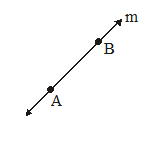
A Line Segment
- Books Name
- CBSE Class 6 Mathematics Book
- Publication
- Param Publication
- Course
- CBSE Class 6
- Subject
- Mathmatics
LINE SEGMENT
A line segment is part of a line. It has two endpoints and has fixed length.
We name the segment by its endpoints.
Point A and B are the two endpoints of the line segment AB as shows here.
![]()
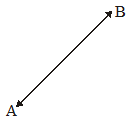
Points
- Books Name
- CBSE Class 6 Mathematics Book
- Publication
- Param Publication
- Course
- CBSE Class 6
- Subject
- Mathmatics
POINTS
A point determines a location. If we mark three points on a paper, we would be required to distinguish them. For this they are denoted by a single capital letter like A, B, C.
These are some models for a point :
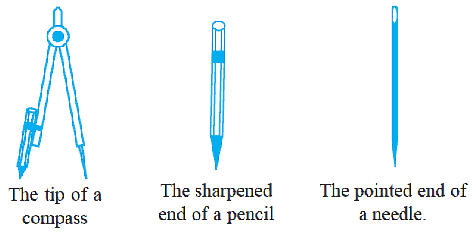
These points will be read as point A, point B and point C. Of course, the dots have to be invisibly thin.
A point has no length and no breadth.


 Param Publication
Param Publication
 ReginaTagebücher
ReginaTagebücher
